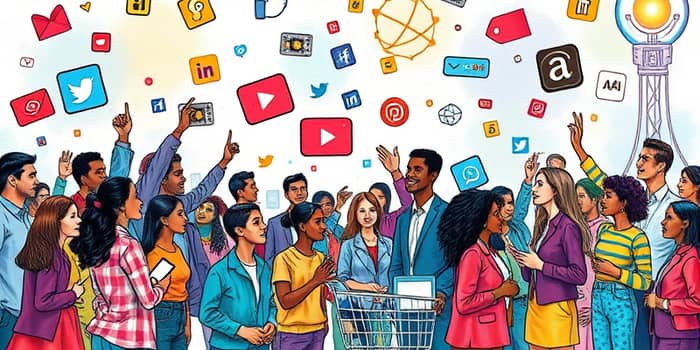
In 2025, social media’s sway over consumer behavior and business strategy has never been more profound. With 5.42 billion users across 6.83 platforms monthly, brands are navigating an expanding digital universe. The rules of engagement have shifted, demanding agility, creativity, and a deep understanding of cultural currents.
This article unpacks the top market trends shaping social media’s influence. From experimental content to AI-driven tactics, we explore how businesses can forge authentic connections and drive measurable growth in an era where social platforms double as search engines and marketplaces.
Social media’s unprecedented scale is evident in its global penetration. Nearly 70% of the world’s population logs in daily, interacting with brands more frequently than ever. In the US alone, 246 million people—72.5% of the population—are active users, underscoring the stakes for businesses that get social right.
Consumer expectations have evolved. Today’s audiences demand responsive, personalized experiences and are 48% more likely to interact with brands that are active and engaging. This dynamic creates both opportunity and challenge as companies vie for attention in crowded feeds.
Beyond numbers, social media shapes the psychology of brand recall. Users create mental “bookmarks” of standout moments—be it a viral campaign or an empathetic response to customer feedback. Brands that embed into these moments translate fleeting impressions into long-term loyalty.
Gone are the days when polished, uniform messaging guaranteed success. Brands now embrace a spirit of real-time content experimentation strategies, tapping into raw, unscripted moments that resonate on a human level. Platforms like Threads and X have empowered companies to share behind-the-scenes glimpses, voice-of-customer stories, and authentic interactions that feel less like ads and more like conversations.
By prioritizing unfiltered, mood-driven content experiences, marketers cultivate emotional connections that outlast fleeting trends. This disruptive approach transforms audiences from passive observers into active participants, fueling micro-virality and deepening brand loyalty.
For example, a global beverage company used spontaneous live Q&A sessions to showcase product development stages, sparking tens of thousands of live interactions in just hours. This approach illustrates how real-time community engagement efforts can amplify brand narratives and humanize corporate voices.
In 2025, AI is embedded at every stage of social strategy. Generative AI tools automate content creation, from drafting posts to designing visuals, allowing teams to personalize content output dramatically at scale. Marketers share their AI prompts and best practices openly, fostering an ecosystem of innovation and continuous learning.
Beyond creation, AI-driven analytics sift through vast social datasets, revealing patterns in sentiment and behavior. Coupled with advanced social listening tools, brands can decode the cultural “vibes” of their audiences. This precision enables timely, context-aware responses and trendjacking with strategic precision, ensuring campaigns align with evolving conversation threads.
Importantly, ethical considerations around AI usage have come to the forefront. Brands clarify when content is AI-generated, promoting trust and transparency. This openness not only strengthens credibility but also invites community feedback, enabling a co-creative process between companies and audiences.
Video continues its reign as the most engaging format on social media. Short-form clips, live streams, and interactive stories capture attention and drive discovery. By weaving brand narratives into episodic video content, companies foster immersive, story-driven brand experiences that spark loyalty rather than fleeting clicks.
Simultaneously, platforms like TikTok, Instagram, and YouTube have metamorphosed into primary search destinations, overtaking traditional search engines in product research and inspiration. To capitalize, brands must optimize posts with targeted keywords, descriptive hashtags, and AI-generated captions that boost discoverability in social search results.
By cultivating micro-communities—whether through private Facebook groups or exclusive LinkedIn circles—businesses provide valued audiences with direct access to expertise, early releases, and personalized support, reinforcing brand affinity. Brands that develop episodic series, featuring customer stories or employee spotlights, see engagement rates soar by over 50%, seamlessly blending stories with algorithmic reach.
Social commerce continues its exponential rise. With in-app purchases projected to surpass $90 billion in the US alone, platforms now serve as fully integrated marketplaces. Shoppable posts, live shopping events, and seamless checkout experiences remove friction from the buyer’s journey.
As 83% of social ad spend shifts to mobile by 2030, brands must prioritize truly mobile-first storytelling strategies and optimized ad formats. Whether through vertically oriented videos or interactive AR filters, mobile users expect intuitive, engaging experiences that bridge the gap between inspiration and purchase.
Innovations like AR try-ons, influencer-led storefronts, and one-click payment integrations streamline the buyer’s journey. By reducing friction, brands tap into impulse purchases and convert browsing into instant transactions, strengthening the link between social engagement and revenue.
In a landscape awash with content and rising ad costs, demonstrating ROI is non-negotiable. Brands have refined their measurement frameworks to focus on three pillars:
Modern ROI frameworks extend beyond clicks and impressions, incorporating metrics such as brand lift, sentiment shifts, and customer lifetime value. This holistic view ensures that campaigns align with broader business objectives and inform future investment decisions.
Case studies reveal that companies leveraging employee networks can generate substantial earned media value. For example, Simpli.fi achieved substantial earned media value of $90,000 in three months by empowering staff to share authentic brand stories on social channels, illustrating the power of human-centric amplification.
To thrive in 2025’s social media ecosystem, businesses must blend creativity with data-driven rigor. Embrace agile content experimentation, harness AI for personalization, and prioritize social listening to stay attuned to audience moods.
Ultimately, the brands that win are those that understand social media as a living dialogue rather than a megaphone. By capturing hearts through authentic stories and using data to guide their next move, businesses transform every like, share, and comment into a stepping stone toward lasting success.
References













